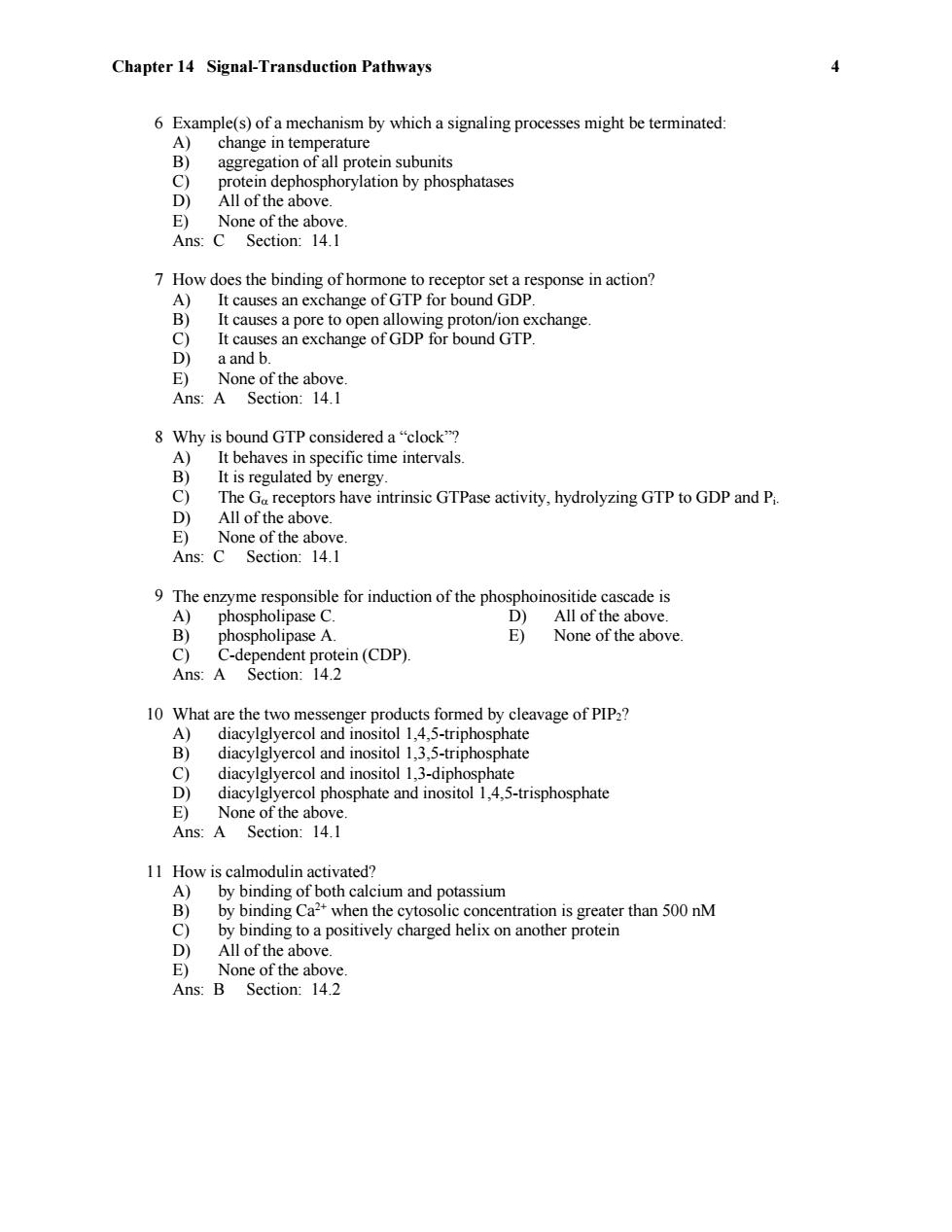正在加载图片...

Chapter 14 Signal-Transduction Pathways 4 6 Example(s)of a mechanism by which a signaling processes might be terminated: A) change in temperature B) aggregation of all protein subunits c) protein dephosphorylation by phosphatases D All of the above. E) None of the above Ans:C Section:14.1 7 How does the binding of hormone to receptor set a response in action? A)It causes an exchange of GTP for bound GDP. B) It causes a pore to open allowing proton/ion exchange. C) It causes an exchange of GDP for bound GTP. D) a and b. E)None of the above. Ans:A Section:14.1 8 Why is bound GTP considered a"clock"? A)It behaves in specific time intervals. B) It is regulated by energy. C) The Ga receptors have intrinsic GTPase activity,hydrolyzing GTP to GDP and Pi. D) All of the above. E) None of the above. Ans:C Section:14.1 9 The enzyme responsible for induction of the phosphoinositide cascade is A) phospholipase C. D)All of the above. B) phospholipase A E) None of the above. C) C-dependent protein(CDP) Ans:A Section:14.2 10 What are the two messenger products formed by cleavage of PIP2? A) diacylglyercol and inositol 1,4,5-triphosphate B)diacylglyercol and inositol 1,3.5-triphosphate C) diacylglyercol and inositol 1,3-diphosphate D) diacylglyercol phosphate and inositol 1,4,5-trisphosphate E)None of the above. Ans:A Section:14.1 11 How is calmodulin activated? A)by binding of both calcium and potassium B)by binding Ca2+when the cytosolic concentration is greater than 500 nM C)by binding to a positively charged helix on another protein D)All of the above E)None of the above. Ans:B Section:14.2Chapter 14 Signal-Transduction Pathways 4 6 Example(s) of a mechanism by which a signaling processes might be terminated: A) change in temperature B) aggregation of all protein subunits C) protein dephosphorylation by phosphatases D) All of the above. E) None of the above. Ans: C Section: 14.1 7 How does the binding of hormone to receptor set a response in action? A) It causes an exchange of GTP for bound GDP. B) It causes a pore to open allowing proton/ion exchange. C) It causes an exchange of GDP for bound GTP. D) a and b. E) None of the above. Ans: A Section: 14.1 8 Why is bound GTP considered a “clock”? A) It behaves in specific time intervals. B) It is regulated by energy. C) The G receptors have intrinsic GTPase activity, hydrolyzing GTP to GDP and Pi. D) All of the above. E) None of the above. Ans: C Section: 14.1 9 The enzyme responsible for induction of the phosphoinositide cascade is A) phospholipase C. D) All of the above. B) phospholipase A. E) None of the above. C) C-dependent protein (CDP). Ans: A Section: 14.2 10 What are the two messenger products formed by cleavage of PIP2? A) diacylglyercol and inositol 1,4,5-triphosphate B) diacylglyercol and inositol 1,3,5-triphosphate C) diacylglyercol and inositol 1,3-diphosphate D) diacylglyercol phosphate and inositol 1,4,5-trisphosphate E) None of the above. Ans: A Section: 14.1 11 How is calmodulin activated? A) by binding of both calcium and potassium B) by binding Ca 2+ when the cytosolic concentration is greater than 500 nM C) by binding to a positively charged helix on another protein D) All of the above. E) None of the above. Ans: B Section: 14.2